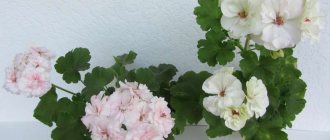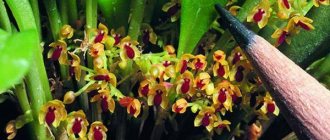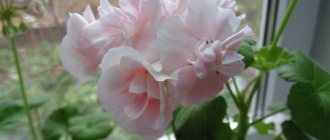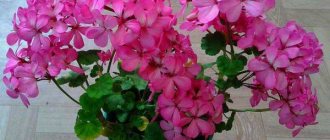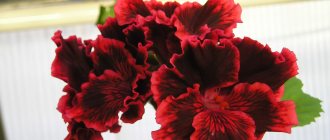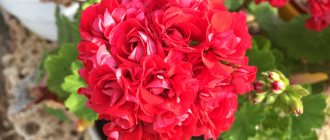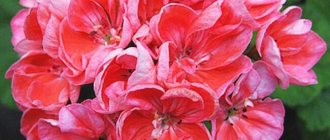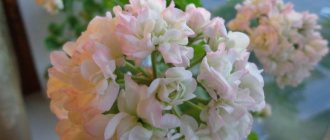Description of popular varieties of pelargonium from the Toscana series
Pelargonium PAC Viva Madeleine, Carolina and other varieties
Thanks to the work of breeders, the color palette is wide, from soft marshmallow (Regina variety) to rich scarlet with dark spots (Dark Red variety). Varieties differ in color, shape, size and type of inflorescences.
Toscana Bernd
Pelargonium Toscana Bernd is a double and zonal beauty. Rare deep red color of inflorescences collected in bright bunches. Pelargonium Tuscany Bernd blooms profusely, covering the entire top with red balls.
Toscana Edwards
Pelargonium with red-orange inflorescences is distinguished by a white lining on the back of the petals and at their base. Pelargonium Edwards Tuscany blooms earlier than its sisters and blooms for a long time.
Edwards Tuscany
Toscana Renske
The red-burgundy small inflorescences of this variety densely cover the surface of the compact bush. The plant can be used as a hanging or potted plant. Blooms early and blooms for a long time.
Toscana Castello
Varieties of this variety come in many shades of red and pink. The inflorescences are dense and resistant to fading. The bush is medium, erect, suitable for planting in flower beds.
Toscana Hero
A beautiful combination of dark red-pink spots on the petals, with a white tint. The hiro bush is dwarf, and the inflorescences themselves are very large. The velvet shade shimmers in the sun. Blooms profusely, almost continuously. Medium size with the same flower color - Tammo geranium.
Variety Hero
Description of the plant
Ivy-leaved geranium is also called creeping geranium, which in itself reflects the characteristics of this plant. The stems of this variety are ampelous, the leaves are similar to ivy not only in shape. They have a smooth surface with a light, subtle shine. Geranium of this species has quite powerful shoots. In most varieties they can reach 1 m in length. At the same time, the shoots cling well to any protrusions on vertical surfaces, quickly rise upward, and later, after flowering, they can scatter seeds around.
Pink and white ivy-leaved pelargoniums
This variety also has elongated peduncles. They are characterized by umbrella inflorescences, uniting 10-15 relatively small flowers. The buds of this variety of geranium are bright. But the flowers of most varieties are already lighter in color. Although there are both dark purple and scarlet varieties, white-pink and lilac varieties predominate.
Advantages and disadvantages of ivy-leaved pelargonium
Ivy geranium is popular with many gardeners due to the following advantages:
- the presence of a large number of varieties with varied shapes and colors of flowers. There are also variegated varieties that look attractive even when they fade;
- ease of cultivation, since this is a very undemanding plant that even a novice gardener can handle;
- abundant flowering;
- Most varieties take root well in both soil and water.
As for the disadvantages, this variety of geranium has practically none, with the exception of one. Pelargonium ivy is difficult to overwinter in an ordinary city apartment. But this is a solvable problem; experienced flower growers advise in such cases to use additional ultraviolet lamps for lighting.
Note! This is often easier than giving such plants a cool winter.
Planting and further care of ivy-leaved pelargonium Tuscany
The non-capricious Tuscany geranium grows wonderfully both in pots and in flower beds in the summer.
Pelargonium SOUTH Shukar, Aksinya, Ireland and other varieties
When planting bushes in open ground, it is important to consider that the roots of the plant are quite long. The depth of the hole should be at least 20 cm. The average distance between standard bushes is 30-35 cm.
Watering, spraying and fertilizing
Watering is needed moderate but regular. The plant will not tolerate stagnation of moisture, nor will it tolerate drying out of the soil.
Important! Spraying will not be beneficial, since moisture will only be retained on the pile of terry leaves.
To maintain flowering, it is important to fertilize the bush once every 14 days, feeding pelargonium with a universal complementary food for flowering plants. In winter, the plant takes a break from fertilizers.
Trimming
Pruning is carried out for the purpose of:
- forming a compact bush;
- for thickening the bush;
- to stimulate flowering by removing shoots that are too long.
Pelargonium pruning should be done on an ongoing basis, starting from early pinching of the cuttings.
Appearance and characteristics of pelargoniums
Pelargonium Tuscany is a miniature flowering bush. This plant loves warmth and does not tolerate frost, so it is grown indoors, and in the summer it is taken out to the balcony, summer cottage, or planted in open ground. If you follow all the rules, the bush blooms throughout the year.
Pelargonium Tuscany has straight or curly stems. The flowers consist of 4 petals and resemble small umbrellas. They come in bright or subtle colors. There are also multi-colored inflorescences. It all depends on the Tuscany pelargonium variety. Usually there are many flowers on one plant.
The leaves are carved, their surface is velvety. They are usually green in color. But there are varieties whose foliage alternates dark and light areas.
Pelargonium is often also called geranium. But it's not right. These are different plants that belong to the same genus - geraniums.
Diseases and pests. Means to combat them
The smell of leaves and flowers repels many pests and insects. Whiteflies or spider mites can live on greenery if preventative treatments are not carried out on time.
Pests on geraniums
Improper watering regime contributes to the formation of gray rot, powdery mildew, and rust.
Pelargonium is a wonderful decoration for any home interior or garden bed. Its unpretentiousness and continuous flowering in the summer season make it a favorite of gardeners.
What is zonal pelargonium, what varieties exist, what is necessary for growing care?
Would you like to know how and with what you can decorate your window sill so that it imitates a small, cozy greenhouse?
Pelargonium will easily help you with this - a flower that can lift your spirits with its appearance and long-lasting flowering. However, this beauty requires some care and proper maintenance conditions. In this article we will tell you how to grow this beautiful flower and how to properly care for it. Watch a video that discusses this topic.
Plant varieties and popular winter-hardy varieties
Sutarve nadya k pelargonium
For flower lovers, several varieties of geranium have been bred, not only distinguished by their ease of cultivation and care. Many of them have an extremely interesting exterior.
"Canon Mills" is a popular variety of geranium with beautiful light pink flowers of uniform color. The variety is just winning the hearts of florists, but has every chance of becoming one of the favorites on the list of favorite varieties. "Alan Bloom" is a geranium variety distinguished by its soft pink flowers. One of the most common varieties of geranium. Has high frost-resistant properties. Unpretentious, suitable for growing in most climate zones. "Striatum" is a summer flower. The peculiarity is the large number of flowers. The striatum is literally completely covered with inflorescences. The variety is very popular in garden and park compositions due to its abundant, long-lasting flowering. This variety is also often called crane grass because of the fruits formed after flowering, which are very similar to the beak of a crane. "Max Fry" is one of the most popular varieties of geranium among garden designers. The plant has large, densely arranged pink flowers.
The flowers attract attention with clearly defined dark veins. “Horizon” is the common name for several varieties of geranium, among which the most popular are Horizon Red Ice and Horizon Star.
The varieties have interesting flower colors, with a contrasting border around the edges.
Variety Striatum
- "Album" is a geranium variety with delicate white flowers and specific decorative foliage. Album is a large-flowered variety; the flower diameter often reaches 3-3.5 cm. Album tolerates frost well and has a long flowering period.
- “Maxima” is a geranium with large double flowers with a bright, rich cherry edging. Maxima gets along well with other types of geranium, while emphasizing its individuality.
- “Maverick Star” is a variety characterized by a compact bush structure, a large number of inflorescences and dense, rich foliage. Maverick will appeal to those who do not have the opportunity to have a large flower bed.
- "Vision pink" is one of the most compact types of geranium. Vision is a small bush, only 15 cm in height, which goes well with tall plant species.
Seed propagation
This propagation method is considered too complicated for novice gardeners; it is suitable only for professionals. If you still want to use the plant’s seed, then the best time for this is in February and lasts until mid-April.
Seedlings can be planted either in ordinary light loose soil or in special peat tablets, but only large ones. Sowing is carried out in holes with depths of up to 10 mm. In this case, the soil should be well moistened; it can be pre-sprayed with a spray bottle. Then the container with the planted seedlings is turned into an impromptu greenhouse, covered with a transparent film. Such pots are placed in a well-lit place, but not in direct sunlight. The first shoots should appear in about a week. And after a month, the geranium can be transplanted into permanent containers.
Note! Not all varieties propagate well from seeds. Many gardeners recommend options such as, for example, Tornado. This is a hybrid with red flowers and a shoot length of 30 cm. The Crystal hybrid is also suitable for these purposes. You can grow several varieties of flowers at home. This set will decorate the most modest cottage.
How to properly care?
Temperature
In summer, the flower prefers to be in a temperate warm climate. The temperature will be 17-23 degrees Celsius. Planting outside is done only after the danger of frost returning has passed. At temperatures of 12 degrees and below, flowering stops. Heat is also unacceptable for the plant, especially indoors. You can tell that a flower is cold by its reddened leaves.
ATTENTION! With the arrival of autumn, it is better to gradually lower the temperature and water the flower abundantly. Growth should not be active, otherwise the plant will begin to stretch out and become exhausted in poor light
Winter period
In winter, pelargonium zonartik is kept in a greenhouse or glassed-in balcony. The temperature should not fall below +6 degrees at night and +12+15 degrees during the day. On sunny days, open windows for ventilation to avoid overheating. In winter, excellent air circulation is important for the flower. Do not place pots close to each other. If necessary, thin out the crowns. This will prevent the development of fungal diseases.
Water in winter infrequently and sparingly. Do this from pallets, carefully measuring the amount of water and time for the next watering throughout the entire container. Moreover, the top of the soil should be dry. Overwintering of pelargonium zonartik can take place in other ways:
- This method involves saving plants as cuttings that have already taken root. In this case, the mother plant is thrown away. This method is used for summer growing pelargonium outdoors.
- This method is also used for keeping flowers outdoors. Before frost, remove the plant from the soil with its roots and shake off the excess soil. Cut the flower and wrap it in paper. Place in a cool basement. Choose a room with excellent ventilation and high humidity. Otherwise, the plant may dry out.
These two methods can be combined: first take cuttings, and then send the mother plant to a cool room for the winter. Wintering occurs at the warmest time and lasts 3 months (November-February). At the end of January and beginning of February, when daylight hours begin to increase, pelargonium begins to gradually awaken.
Watering
REFERENCE! Pelargonium zonartik is a moisture-resistant plant, but at the same time it is susceptible to fungal diseases. So it’s better to underwater it than to overwater it.
In summer, watering is carried out as the top layer of soil dries. In this case, the plant should be in a warm and sunny place. In winter, limit watering, but do not allow the soil to dry out completely. Excessive moisture can be recognized by drooping and limp leaves. In addition, symptoms of gray rot will begin to appear.
In severe cases, the stem rots, which ultimately leads to the death of the flower. Another symptom of excess moisture is the “sores” that form on the underside of the leaves. When the earthen clod dries out, flowering stops, the leaves turn yellow, and the edges die. For irrigation, only settled, warm and soft water is used. Air humidity is not important for pelargonium zonartik.
These flowers do not need spraying. Excessive humidity and stagnant air promote the development of fungus.
Feeding
Fertilizing should be introduced with each watering, while reducing the dosage. For example, if moistening is carried out daily, then the weekly fertilizer rate should be divided by 7-10. Apply the resulting dosage to each watering. If the lump of earth has dried out between irrigations, moisten it with clean water.
During the winter rest period, fertilizing should not be applied if the temperature is low and the plant is completely resting. When slight growth of the flower is visible, the introduction of fertilizer should be restored to ¼ dosage. After rooting the cuttings, fertilizer with a high concentration of nitrogen is used.
ATTENTION! To feed young plants that are too early to bloom, use a complex universal fertilizer. Before flowering, 2-3 months, you will need to use a fertilizer with a high concentration of potassium. If there are signs of chlorosis, treat with magnesium sulfate and iron chelan
If there are signs of chlorosis, treat with magnesium sulfate and iron chelan.
Propagation by cuttings
Ivy-leaved geranium, that is, ampelous, is most often propagated by stem cuttings. It is best to carry out this procedure in August-September. The average length of a stem cutting suitable for propagation should be 5-15 cm.
Important! To propagate the plant, experienced gardeners advise taking semi-lignified cuttings that are green on top.
Cuttings should be separated from the mother bush with a sharp knife. You cannot tear them off, as this can damage the plant. The trimmings obtained in this way are left for a day, waiting for the sections to dry properly. Then, for disinfection purposes, they are treated using activated carbon (although it is better to use charcoal).
To root the cuttings, it is recommended to pre-heat the soil in the oven to prevent infection or pests from getting there. The cuttings are planted at a distance of 2 cm from each other.
